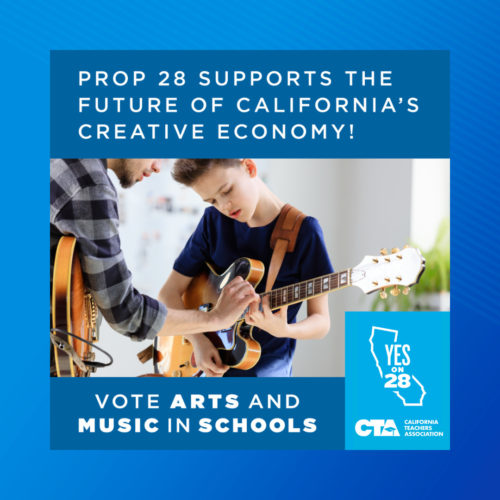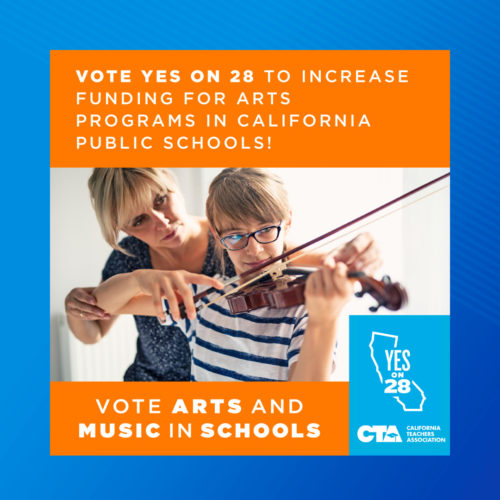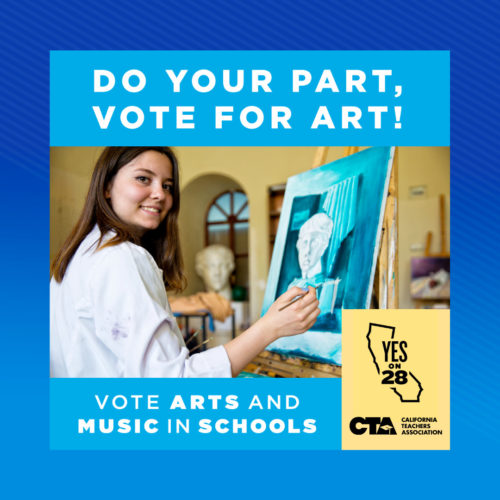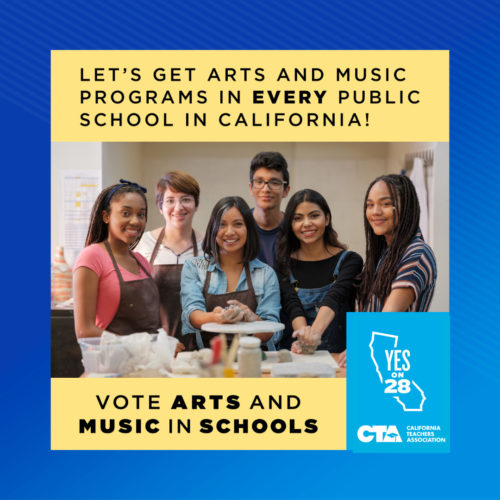Arts and music education plays a critical role in the development of students in K-12 and beyond. Unfortunately, only 1 in 5 public schools have a full-time accredited arts or music teacher. Without raising any new taxes, Prop 28 would rectify this by making the largest investment in arts and music education in the country, helping put students on the path towards a successful future with a good-paying job.
Prop 28 will provide more than $900 million every year to arts and music education in California public schools – without raising taxes. Join us in voting YES on Prop 28.
#Prop28 will provide more than $900 million every year to arts and music education in California public schools – without raising taxes. #WeAreCTA #VotePublicEd
Tweet ThisCalifornia educators support #Prop28 because arts and music education improves cognitive development, correlates with higher student achievement in reading and math; and leads to increased school attendance. #WeAreCTA #VotePublicEd
Tweet ThisDid you know that only one in five public schools has a full-time accredited arts or music teacher? The arts are frequently the first programs to get cut. #Prop28 will invest in arts education without raising taxes. #WeAreCTA #VotePublicEd
Tweet ThisArts and Music in Schools Initiative FAQ
The initiative will provide more than $900 million every year to arts and music education in California public schools – without raising taxes. If passed, the measure would be the largest investment in arts and music education in the country.
Arts and music education plays a critical role in the education and development of students, but unfortunately has been underfunded in California. Only one in five public schools has a full-time accredited arts or music teacher, and arts education are frequently the first programs to get cut.
Study after study has demonstrated the importance of arts and music education in the development of children and their success in school and in life. Arts and music education improves cognitive development, reasoning, and language acquisition; it correlates with higher student achievement in reading and math; and it leads to increased school attendance.
Participating in the arts is especially vital now to support students’ mental wellbeing amidst the ongoing impact of COVID-19.
70% of the funding gets allocated to every public school in the state based on their enrollment of preK-12 students. The remaining 30% is allocated as an additional amount to schools serving economically disadvantaged students and communities to ensure more equitable access to arts and music education.
The initiative requires 100% of the additional school funds to be used for arts and music education, with at least 80% on hiring teachers and aides. The funding can also help with staff training, supplies, materials, and educational partnerships with arts and community organizations.
The measure includes strict accountability measures to ensure the funds are spent as intended—to directly benefit students. It prohibits schools from diverting existing funds away from arts and music education.
Austin Beutner, who has served as LA Unified Superintendent and CalArts Board Chair, is leading a coalition of teachers, artists, musicians, businesses, community groups, labor, entrepreneurs and arts organizations in support of the measure.
The measure’s supporters include Actors’ Equity Association, California IATSE Council, Dr. Dre, will.i.am, Issa Rae, John Lithgow, Jeff Bridges, Sylvester Stallone, Amy Brenneman, Jimmy Iovine, NBCUniversal, Fender Music, CAA Co-chairman Richard Lovett, Los Angeles Urban League President Michael A. Lawson, Quincy Jones, Universal Music’s Sir Lucian Grainge, Frank Gehry, Live Nation’s Michael Rapino, The Recording Academy’s Harvey Mason Jr., Oakland Museum of California’s Lori Fogarty, LA County Museum of Arts’ Michael Govan, Pearl Jam and many more.
The impacts of underfunded arts and music education in our public schools fall hardest on low-income communities, and particularly the Black and Latino students who comprise 61% of total PreK-12 enrollment and 77% of enrollment in low-income communities. Funding arts education – with emphasis on underserved communities – will help close this gap.
The initiative is timely as our country seeks to create a more just and equitable future. A boost in arts and music education will help ensure the future workforce in media and technology properly reflect the diversity of the children in our public schools.
“This ballot measure will help define the promise of the next generation of storytellers by ensuring all California students get the high-quality arts and music education they deserve,” adds ballot measure supporter Issa Rae, actress, writer and producer. “It will especially benefit students from communities of color, who often experience a lack of access and equity in access to arts and music education.
The measure ensures all 6 million students in public schools have access to the foundational education needed to participate in our state’s creative economy – and that companies in the creative economy have access to the diverse workforce they need to succeed.
The measure uses an expansive and current definition of arts that reflects the changing nature of the arts and arts-related industries. Specifically, the measure defines arts to include dance, media arts, music, theatre, and visual arts, including folk art, painting, sculpture, photography, and craft arts, creative expression including graphic arts and design, computer coding, animation, music composition and ensembles, and script writing, costume design, film, and video.
The measure allocated existing revenue from the state General Fund, which currently has a surplus of nearly $100 billion. The amount dedicated to arts and music education under the measure is equal to roughly 1% of existing education funding – and is in addition to that funding, not counted towards it.




